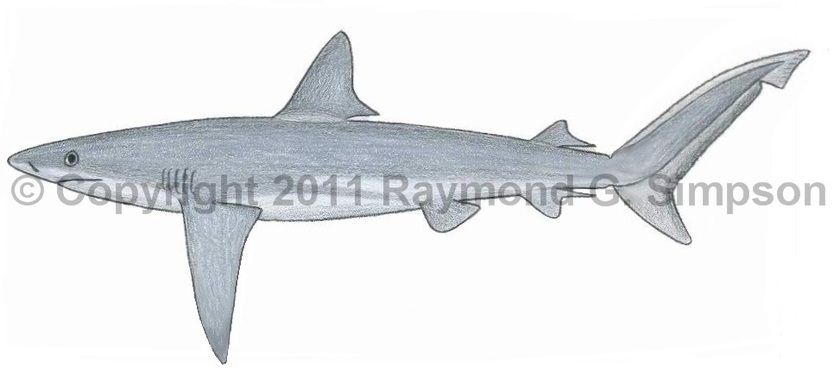
Common Name
Galapagos Shark
Year Described
Snodgrass and Heller, 1905
Identification
Anteroposterior tooth rows: 13-15/13-15 on each side; 27-31/27-31 total
Vertebrae: 103-109 precaudal, 200-215 total
A large and fairly slender shark with a small and rounded snout. Eye large. Distance between nostrils 1.0-1.3 times in pre-oral distance. Nasal flaps rudimentary. Upper labial furrows short. A low interdorsal ridge is present. Long preanal ridge absent. No keels on caudal peduncle. Gill slits rather short (2.8-3.5% TL). Teeth in upper jaws triangular and serrated, with a slightly oblique to erect cusp, and a slight notch on the rear margin. Lower jaw teeth thick-based, with slender, serrated, and erect cusps. First dorsal fin high (9.5-11.2% TL) with a convex or straight anterior margin, a rounded to pointed tip, and inserted over posterior margin of pectoral fin. Second dorsal fin much smaller (2.6-2.8% TL) and inserted almost directly above anal fin (sometimes slightly anterior). Both dorsal fins with extended free posterior tips (second dorsal free tip shorter than twice height of second dorsal). Anal fin similar in size to second dorsal fin. Pelvic fin origin well behind free tip of first dorsal. Pectoral fin long and triangular, with a pointed tip.
Color
Dark gray above, abruptly whitish below. Fins rarely with dusky tips.
Size
Mature adults from 170-300cm TL (females average larger). Newborns from 57-80cm. Maximum size to 370cm TL.
Habitat
Inshore near bottom and offshore pelagic from 0-180m. Most common at insular localities, where it occurs commonly over rocky reefs.
Range
Widely scattered records near islands: Bermuda, the Lesser Antilles, and offshore Brazilian islands (St. Paul's Rocks).
References
Castro, J.I. 2011. The Sharks of North America. Oxford University Press, 640 pp.
Compagno, L.J.V. 2002. Sharks. In: Carpenter, K.E. (Editor) FAO Identification Guide for Fishery Purposes. The Living Marine Resources of The Western Central Atlantic. Volume 1: Introduction, mollusks, crustaceans, hagfishes, sharks, batoid fishes, and chimaeras. ASIH Special Publication No. 5. FAO, Rome.
Compagno, L., M. Dando, and S. Fowler. 2005. Sharks of the World. Princeton University Press, 480 pp.